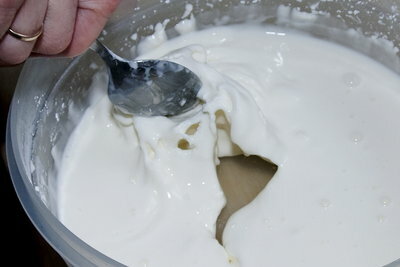Great experiments for kids
Are you looking for great experiments for children? Then just go into your kitchen and mix a starch paste that invites you to interesting experiments.

What you need:
- 400 g starch powder (Maizena, Gustin etc.)
- 600 - 700 ml of warm water
- a bowl
- strength and endurance
- Materials depending on the experiment
How to make the mysterious porridge
Even if it doesn't sound very convincing, starch pulp is a very surprising material that can invite children in particular to great experiments. And: You actually only need materials that you have at home anyway.
- Use starch powder for these experiments, never use flour.
- Mix the starch with the warm, not hot (!) water in a large enough bowl. But take it slowly and carefully. Because as you will notice, at a certain point you need a lot of strength to stir the pulp. Even an electric mixer can come to an end, because the starch paste solidifies to an unimaginable degree when stirred briskly.
Perform great experiments with the magic mush
- As soon as you stir it, you will have noticed that the mixture actually looks nice and liquid, but becomes tough and crumbly if you stir it through. This property can be used to conduct great (and unexpected) experiments.
- For example, start with second dumplings. Have a board ready and knead a handful of dough into a beautiful (and maybe even appetizing) Dumplings. However, if you place it on the board, the dumpling, no matter how beautiful it is, melts back into a mushy mass within seconds.
- The mixture is also suitable as a "solid rubber ball". Fill some of this into a small balloon or a well-sealable plastic bag. Then forcefully toss your "ball" on the floor or a wall. Did he come back? And how does your ball behave if you work it with a hammer, initially tentatively, but then more heavily?
- You can also create a kind of "starch sump" with the unusual pulp. The fast you work around with your feet (or fists) in it, the less you will sink into the swamp. But be careful: You shouldn't plead fatigue, because then you will sink into your swamp experiments.
Fire, water, air - research in the day care center
Experimenting, observing, gaining scientific knowledge: you can ...
Dilatancy is the cause
- Materials such as starch pulp (and, by the way, also the well-known magic putty), which solidify under (heavy) use, are called "dilatant".
- Impact work turns such materials into a really stiff mass, because the internal structure changes and with it the viscosity. (By the way, the counterpart to this is ketchup, which liquefies when shaken.)
- The pulp from your great experiments is nothing more than particles of starch that are found between small spaces filled with liquid.
- If you move the mixture carefully, the water ensures that the starch particles can move around well, similar to a lubricant.
- However, if you exert strong forces or great pressure, the starch particles are pressed against each other: They not only hinder each other's movement, but also get caught. And: The lubricant that is so necessary collects in larger spaces. The pulp just solidifies.
- However, this process is reversible: if you leave the porridge alone, the water flows back into all available channels and the second dumpling disintegrates before your eyes.
How helpful do you find this article?


